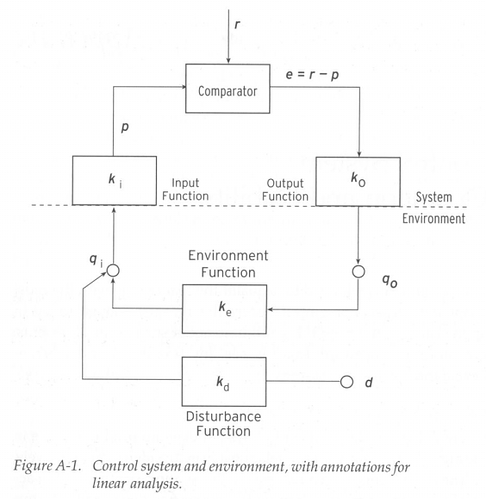[From Bruce Abbott (2015.09.29.11:00 EDT)]
Last night I watched a talk on YouTube by Charles Gilbert of the McGovern Institute for Brain Research at MIT (https://www.youtube.com/watch?v=Bwrwa4Sx4-U ) that summarized some of his and his collaborators’ work on the neuroscience of vision. At one point Gilbert said the following: “For every area [of the cerebral cortex] where there is a feedforward connection, there is also a feedback connection.” Bill Powers suggested long ago that this would prove to be the case, based on his theoretical view (HPCT) that the nervous system is organized as a hierarchy of control systems, with the outputs of higher levels of the hierarchy setting the reference levels for the control systems immediately below them in the hierarchy. However, although Gilbert’s statement could be taken as support for HPCT, his analysis of the role played by these feedback loops does not necessarily conform to their role as envisioned in HPCT.
Before I describe how Gilbert’s analysis differs from HPCT, it might be worth spending a bit of time talking about those two terms, “feedforward” and “feedback.” In neuroscience these terms usually (always?) refer to the processing of neural signals within specific areas of the cerebral cortex (or other brain structures, but here we are concerned with the cortex). In the visual system, neural impulses arrive first in area V1 of the occipital lobes at the very backs or the cerebral hemispheres. Adjacent areas of V1 receive input from adjacent areas of the retinas of the eyes (topographic organization). Many years ago Hubel and Wiesel identified columns of cortical neurons in V1 that respond best to lines of particular orientations that have been projected onto the corresponding areas of the retina from which the signals come. Thus, some cells respond best to vertical lines, some to a horizontal lines, and others to lines of various orientations between those two values. Thus, line orientation at a given location on the retina is indicated in cortical area V1 by which of the corresponding line-orientation cells is most active.
In the language of neuroscience, information from the retina is being “fed forward” to the thalamus and from there to cortical area V1, where analyzers signal the presence of lines of particular orientations falling across the corresponding areas of the retina. Presumably, these orientation signals are then “fed forward” to other cortical structures that become active when particular combinations of line angle are present (perhaps defining the edges of an object, for example). The idea is that there is a sequence of stages of processing that build up the perception of objects with their various visual properties, from the bottom level up. This is called “bottom up” processing. The perceptual hierarchy of HPCT defines a kind of bottom-up processing in which higher-level variables are built up from combinations of lower-level variables.
Gilbert notes that each higher-level mechanism involved in bottom-up processing has neural connections that go back to the lower-level structures, thus “feeding back” information from the higher structures to the lower ones. In HPCT these feedback loops are assumed to provide reference values from levels higher in the perceptual hierarchy to the levels immediately below. Gilbert suggests that these feedback connections provide the means through which processing can occur in “top down” fashion. For example, imagine that you are scanning a set of photographs looking for a particular person. Because you know what that person looks like, you have a kind of template that can be used in that search. Gilbert imagines that the signals feeding back from the high level in which you perceive that person to the lower levels set those lower levels to be differentially sensitive to those lower-level features that more or less match the template [my interpretation of Gilbert’s view; I could have it wrong]. In fact, Gilbert suggests that this is accomplished by setting the gains of the relevant feature detectors.
Not that, as used here, the term “feedback” does not necessarily refer to a variable’s value being fed back onto itself, as it does in PCT. Instead, it usually refers to signals being sent to earlier-level structures in the processing of the information. These “top down” influences set the lower-level processes to respond better to certain features present in their inputs than to others, so that, for example, when the image of that person you were looking for is present on a photograph, you immediately see it.
Gilbert illustrates this top-down process with one of those photos that seem to offer nothing more than black and white blobs when first examined. However, when you are shown a more detailed version of the image, reexamination of the original photo now produces instant recognition of the object in the picture. Seeing the more detailed photo told your perceptual mechanisms what to look for.
Bill Powers suggested that in some cases reorganization might involve altering the loop gain of a control system rather than changing the connections among components, so the idea of manipulating gains is not entirely foreign to PCT. However, Gilbert’s use of gains is to tune the appropriate lower-level filters to more easily detect features that match the template, should the be present in the input. Thus you become more likely to see what you expect to see, (or have learned to see), even if the match is somewhat sketchy.
Bruce



